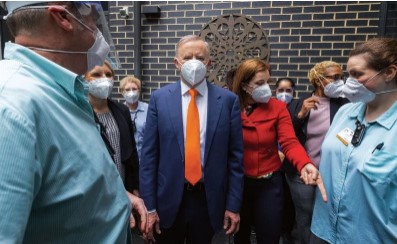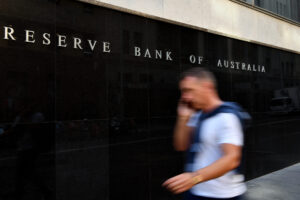
If a pandemic killed 15,000 people and nobody seemed to notice, was it really a pandemic? In Australia last year, COVID-19 killed more people than lung cancer, breast cancer, prostate cancer, car accidents and drowning combined. And in addition to the 15,000 deaths directly attributed to COVID, the Australian Bureau of Statistics tells us that there were 20,000 more deaths last year than would usually be expected, largely due to the fact that people who have had COVID tend to die more quickly of the other diseases they have. Last year was the first time that average life expectancy has fallen in Australia since World War Two.
But over summer it is likely more Australians would have seen warnings about the dangers of drowning in a rip than the dangers of kissing strangers on New Year’s Eve. As Australia enters its fourth year of living – and dying – with COVID, our leaders have grown tired of talking about it, and, as a result, the “silent pandemic”, as Professor Brendan Crabb describes it, shows no sign of tiring of taking its awful toll.
I don’t want to go back to lockdowns and few, if any, experts are suggesting we should. Lockdowns were hard on all of us – our communities and our economy – but they bought us the precious time we needed to develop and roll out the vaccines that have likely saved hundreds of thousands of Australian lives. Lockdowns were hard work, but they worked as intended when we had no other weapons with which to fight.
But despite the fact that our state and federal governments now have a diverse arsenal with which to fight the virus, most of those weapons lay idle and decaying from lack of use. Masks only work if people wear them, social distancing is less effective when indoor air isn’t well filtered and flushed, tests don’t work if they aren’t taken, and the vaccines that cost so much to develop don’t work if they aren’t injected into people’s arms.
Scott Morrison paid a heavy price for his abject failure to meet his own vaccine rollout targets, and for his callous and clumsy approach to testing. And rightly so. But, despite the fact that only around 44 per cent of those eligible for the fourth booster jab have had one, there is no sign of urgency from the Albanese government, and with an understandable lack of pressure on it from the Opposition, very little scrutiny of Labor’s performance in that regard.
In December, Health Minister Mark Butler spoke about COVID on multiple occasions, mainly in relation to restrictions on Chinese travellers coming into Australia. But he issued the same number of press releases on COVID as he did on HIV and Japanese encephalitis: one each. The federal government spent more time in January defending dodgy carbon credits than it did promoting booster jabs.
While the tyranny of distance made Australia’s early response to COVID among the best in the world, our performance has been trending downward ever since. It took the Morrison government longer to distribute our first doses of vaccine than it took the world’s scientists to invent one. And ever since Morrison decided to let it rip back in December 2021, where once our case number and death rates were very good by international standards, they have trended up dramatically and our vaccination rates have trended down. At the time of writing, our daily case numbers, per head of population, are well above those of the United States, United Kingdom, New Zealand, and the average for all rich countries.
Last year’s change of government had a big impact on our public debate but no impact on COVID performance. It is understandable that the Coalition doesn’t want to dredge up its track record and agitate its right-wing supporters by talking about the need to do more on the pandemic. And it is understandable why the Albanese government, under no pressure to set targets or lift its performance, would set goals that some won’t like and that might not be met. But the fact that a lack of action makes perfect political sense doesn’t mean it makes any policy sense.
Years after discovering COVID was an airborne disease, most schools, hospitals, aged-care homes and shopping centres have no better filtration systems. We have barely started the enormous job of clearing up our air the way that 18th-century cities cleaned up their water. We know what needs to be done, we just haven’t prioritised doing it. Australian laws require builders installing granite benchtops to wear masks to protect them from the airborne silica particles that can be so dangerous to their lungs. Yet it’s apparently inconceivable today that we would ask people to wear masks to protect health, aged-care or retail workers. And as for vaccination rates, even if we didn’t care about the tens of thousands of people that COVID is killing each year, why aren’t all the business leaders and economists who drone on endlessly about “skills shortages” up in arms about the enormous consequences for our labour force of millions of people getting sick, hundreds of thousands of people suffering from long COVID, and thousands of working-age people dying before retirement age? If the lack of concern about the human toll of COVID is surprising, then the lack of concern about its ongoing impact on the economy is even more so.
Although we know how to prevent the spread and severity of COVID, we are only just discovering what its lasting impacts on Australians are likely to be. Recent evidence suggests that up to one in 10 Australians may end up with long COVID, which refers to a collection of symptoms ranging from fatigue to diseases of the heart, lungs, blood and brain.
While casual workers have no access to paid sick leave, those permanent employees still lucky enough to have it typically get around 10 days per year. Although politics means there are no longer any mandatory isolation periods for those with a confirmed case of COVID, the science still suggests isolating for at least five days is prudent. But, like our schools, hospitals and shopping centres, Australia’s sick-leave system was not designed with COVID in mind, and, in turn, there is little discussion of the implications for personal finances and the national labour supply of hundreds of thousands of people taking time off work due to long COVID.
Sudden changes in direction can save lives or cost them. And while it was Scott Morrison at the wheel when we began to steer away from COVID-zero, the Albanese government is now responsible for the near-zero level of concern about making Australian communities COVID-safe.
It’s not surprising that after years of sporadic lockdowns, bans on large indoor gatherings, and strict limits on the number of people that could attend weddings and funerals, Australians are weary of defending themselves against the virus. But that is all the more reason for our leaders to lead, both with the encouragement to take simple measures that will save lives, and with the provision of the resources to make our public spaces safer. New strains of COVID are coming our way, and in all likelihood so are brand-new airborne diseases as well. The simple truth is that as our population grows in size and density, the odds of new deadly diseases evolving and spreading grow exponentially.
But solutions exist. The clearest proof that masks, fresh air and social distancing are incredibly effective ways to keep us safe was the collapse in the number of Australians who died from influenza in 2022. Last year was the first time in decades that “the flu” did not appear in the top 20 causes of death in Australia. Those in densely populated Asian countries have been wearing masks in public for years – refusing to wear them is like refusing to wear seatbelts.
Many opponents of lockdowns argued that the sooner we all got a case of COVID the sooner we would all get immunity, and they were completely wrong. Just as we have never evolved an immunity to the common cold, there is no evidence that we are evolving an immunity to its nasty COVID cousin. Vaccines help reduce the spread and seriousness of infection but don’t offer complete protection. Masks and social distancing help but are only highly effective when widely practised. And only governments can insist on improvement in indoor air quality where large groups gather. In short, government policy has a decisive role to play in determining how many people will die from COVID.
The fact that there is little political pressure on the Albanese government to do more to save Australian lives, and the Australian labour force, from being ravaged by COVID doesn’t mean it’s not good for the country to do so. As with building new coalmines, banning poker machines and so many other issues, the fact there is bipartisan consensus that something isn’t a problem is often the clearest proof that it is.
Between the Lines Newsletter
The biggest stories and the best analysis from the team at the Australia Institute, delivered to your inbox every fortnight.
You might also like
Millionaire Tim Gurner’s Refreshing Honesty Reveals the Soul of Business
Every now and then a window opens into the soul of the business community, and we catch a glimpse of the values and goals that shape the actions of the captains of industry.
Why Does the RBA Want More Unemployed Aussies?
By chasing an invisible and moving target, the RBA’s theories on unemployment and inflation could jeopardise the jobs of 140,000 Australians.
New Report Reveals Changing Face and Future of Self-Employment
A new report by the Australia Institute shows self-employment in Australia has changed in recent years, towards fewer business owners and more gig work.

